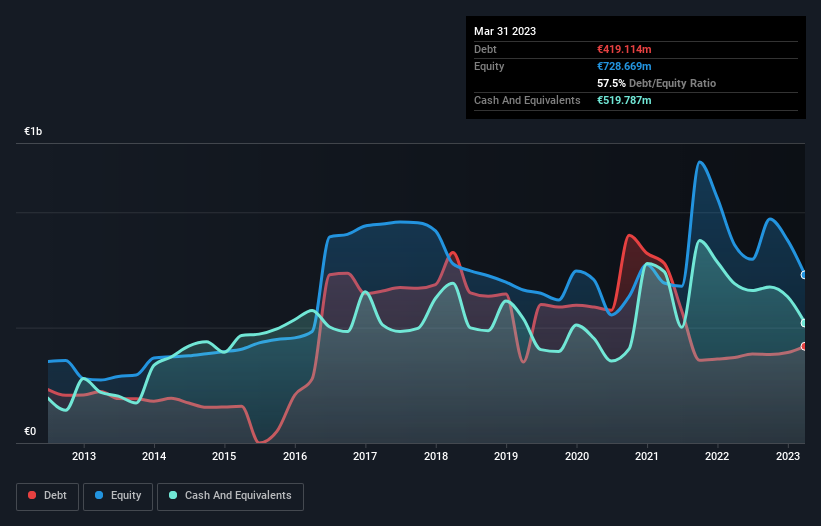
Legendary fund manager Li Lu (who Charlie Munger backed) once said, 'The biggest investment risk is not the volatility of prices, but whether you will suffer a permanent loss of capital.' So it seems the smart money knows that debt - which is usually involved in bankruptcies - is a very important factor, when you assess how risky a company is. As with many other companies Nordex SE (ETR:NDX1) makes use of debt. But the more important question is: how much risk is that debt creating?
When Is Debt Dangerous?
Debt assists a business until the business has trouble paying it off, either with new capital or with free cash flow. If things get really bad, the lenders can take control of the business. However, a more frequent (but still costly) occurrence is where a company must issue shares at bargain-basement prices, permanently diluting shareholders, just to shore up its balance sheet. By replacing dilution, though, debt can be an extremely good tool for businesses that need capital to invest in growth at high rates of return. The first step when considering a company's debt levels is to consider its cash and debt together.
See our latest analysis for Nordex
What Is Nordex's Net Debt?
As you can see below, at the end of March 2023, Nordex had €419.1m of debt, up from €370.1m a year ago. Click the image for more detail. But it also has €519.8m in cash to offset that, meaning it has €100.7m net cash.

How Strong Is Nordex's Balance Sheet?
We can see from the most recent balance sheet that Nordex had liabilities of €3.45b falling due within a year, and liabilities of €364.1m due beyond that. Offsetting this, it had €519.8m in cash and €1.03b in receivables that were due within 12 months. So it has liabilities totalling €2.26b more than its cash and near-term receivables, combined.
This deficit is considerable relative to its market capitalization of €2.38b, so it does suggest shareholders should keep an eye on Nordex's use of debt. Should its lenders demand that it shore up the balance sheet, shareholders would likely face severe dilution. While it does have liabilities worth noting, Nordex also has more cash than debt, so we're pretty confident it can manage its debt safely. There's no doubt that we learn most about debt from the balance sheet. But it is future earnings, more than anything, that will determine Nordex's ability to maintain a healthy balance sheet going forward. So if you want to see what the professionals think, you might find this free report on analyst profit forecasts to be interesting.
In the last year Nordex wasn't profitable at an EBIT level, but managed to grow its revenue by 17%, to €6.0b. We usually like to see faster growth from unprofitable companies, but each to their own.
So How Risky Is Nordex?
Statistically speaking companies that lose money are riskier than those that make money. And the fact is that over the last twelve months Nordex lost money at the earnings before interest and tax (EBIT) line. Indeed, in that time it burnt through €527m of cash and made a loss of €562m. While this does make the company a bit risky, it's important to remember it has net cash of €100.7m. That kitty means the company can keep spending for growth for at least two years, at current rates. Summing up, we're a little skeptical of this one, as it seems fairly risky in the absence of free cashflow. When analysing debt levels, the balance sheet is the obvious place to start. But ultimately, every company can contain risks that exist outside of the balance sheet. Case in point: We've spotted 2 warning signs for Nordex you should be aware of.
If, after all that, you're more interested in a fast growing company with a rock-solid balance sheet, then check out our list of net cash growth stocks without delay.
Valuation is complex, but we're here to simplify it.
Discover if Nordex might be undervalued or overvalued with our detailed analysis, featuring fair value estimates, potential risks, dividends, insider trades, and its financial condition.
Access Free AnalysisHave feedback on this article? Concerned about the content? Get in touch with us directly. Alternatively, email editorial-team (at) simplywallst.com.
This article by Simply Wall St is general in nature. We provide commentary based on historical data and analyst forecasts only using an unbiased methodology and our articles are not intended to be financial advice. It does not constitute a recommendation to buy or sell any stock, and does not take account of your objectives, or your financial situation. We aim to bring you long-term focused analysis driven by fundamental data. Note that our analysis may not factor in the latest price-sensitive company announcements or qualitative material. Simply Wall St has no position in any stocks mentioned.
About XTRA:NDX1
Nordex
Develops, manufactures, and distributes multi-megawatt onshore wind turbines worldwide.
Adequate balance sheet with moderate growth potential.

